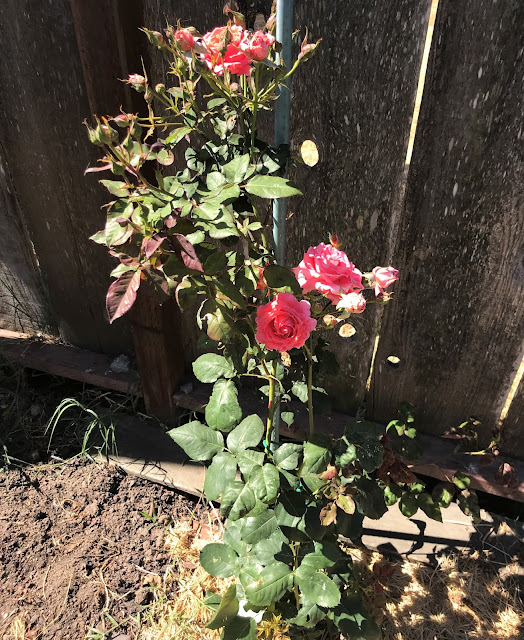America is back!
 |
| America, large flowered climber, 1976 |
One of the lesser traumas gardeners face when planting bare root roses isn't their fault. A mix up back at the processing plant often results in one rose getting put into another rose's package.
When its time for the wrapping and labeling, the flowers, of course, are long since gone. The leaves were stripped off in the field and the canes shortened for easier and more uniform packaging. When reduced to bare root status, many of the canes look the same. They are all grafted onto the same rootstock so examining its roots offers no help.
Inevitably, the true identity of a rose is lost and the bush ends up being mislabeled. Processing plants handle roses in a scale of thousands at a time.
In my case, after years of resisting any new roses in my garden and risking the chance that the bargain bin bare root rose might be infected with rose mosaic virus, I took the plunge this past January and bought Handel.
It was a variety I grew during my first year or two in Salinas and holds the distinction of being the only rose out of the 250 plus varieties I grew that fell victim to a gopher!
My residential neighborhood is gopher free but one maverick critter moved into a neighboring yard when that house was unoccupied and ill-kept for several months.
Handel had provided quick growth up the side of my potting shed and a bountiful supply of white trimmed in bright pink blooms. Suddenly, one day it didn't look so good. The next day it was dead. Panic set in.
None of my roses are planted in wire cages. I bought and used a box trap and caught the gopher within six hours. No further gopher incident has occurred.
So it was with some enthusiasm that I bought Handel this past winter and selected a good and vacant part of the back fence as an ideal spot. It leafed out and stayed pretty much the same size for two months. Then it began sending up long canes and those canes then sported huge sprays of flowers.
The plant seemed to be happy with its location and grew plentiful dark green leaves. The flower clusters grew larger and longer.
When the first flowers opened -- they were orange. The plant was definitely not Handel.
The orange flowers looked familiar though. In fact, I have seen this same rose bush growing in many yards in Salinas. It definitely likes it here. Then, I realized what I was growing -- America!
 |
| America sporting its first cluster of blooms |
Incidents such as this happen occur regularly in home gardens with many people calling one rose something that it isn't.
I recognized America because I'd also once grew it. It's demise in my yard had more to do with its vigor and the inappropriate place where I'd planted it. I didn't know it was going to get so long and lanky so I dug it out and gave it away.
It's no matter that Handel never made a return engagement. America is back.
 |
| Planted in February, America will climb to the top of this seven-foot fence producing large clusters of flowers as it goes. |
No comments:
Post a Comment